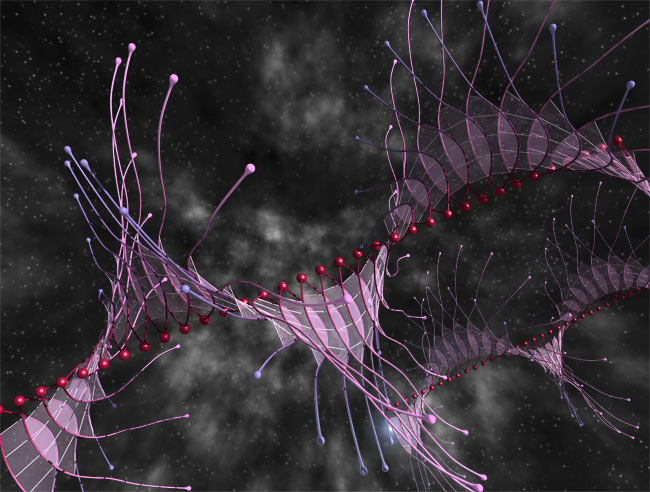hagopini
Extremely flexible and self-assembling into a myriad of formations in a flash, hagopinis perform everyday ballet for the star-dimpled universe.
description
A simple design. Two plixebli wires each tipped with an antenna droplet protrude from a red hlabulle. A variable number of beams (three to eight), called drivastirs, connect the two wires and form a supporting structure for the solpan. The shape and the colour of the plixebli wires are set at the time of manufacture and remain the same throughout hagopini's life-span. At the last survey of spaceblooms (2267), there were 165 shapes and 21 colour schemes mixed in 2,448 strains. The three most popular strains are shown here. (Letter denotes colour, number denotes shape.)
habitat + formations
Hagopinis rarely appear alone, in-stead they create a temporary, complex subformation called hagogamu. Widely distributed throughout deep space, cynmiklae and hucospheres, the formations depend on hagogamu's shape. Flymation: vertebrae train and chimney worm. Flomation: diformae. Secoli 16,384 hagopinis in no more than 512 hagogamus. Ambibloom (some hagogamus shapes are polyblooms while others are not). Gradac depends on hagogamu's shape.
usage
Completely edible. Hlabulles contain tropopneusalus, a substance that helps with breathing in extremely hot conditions and can be used by humans as well as animals. The hollow plixebli wires contain Martian milk, a white liquid paste of deactivated fermentosi. The pair of antenna droplets on each hagopini can be microfused together into the titenpoc, a versatile chemical used as an edible fragrance agent or as a get-rid-of-unwanted-guests air freshner (rudimentary programming required). Titenpoc is also used to produce hopa, a retro hallucinogen. Hagopinis are used to help students of dance with rhythm and complex moves.
library
Hagopini's library is focused on small-scale, steam-driven solar power plants and two-way electrical networks.
defence + hazards
No defence. Be careful around the complex hagogamus when they are splitting and regrouping.
recipes
Fresh hagopinis rule. Just approfix, fold into a manageable size and bite. From the sweet tasting hlabulle all the way to the zesty lime tail antenna droplets, hagopinis are packed with fibre and carbohydrates, not to mention tasty betsuoranels. And do not forget the crispy solpan. Your head may spin, and you will sing. When it stops, try troplets. Abox as many crumbled hagopinis as possible, bebox 50g ahasmiks and cebox 0.2 kg honeygons; unimbler ![]() ad+tr. Out come tiny crunchy caramelized pyramids. Served with ice cream, troplets make a powerful aphrodisiac; without the ice cream, they are a near cure for dyslexia.
ad+tr. Out come tiny crunchy caramelized pyramids. Served with ice cream, troplets make a powerful aphrodisiac; without the ice cream, they are a near cure for dyslexia.
Feeling tired and can't see the summit? You better have some takat danadar. Loaded with energy that goes directly to the blood stream, this bar has saved many distance runners. Abox a large perforated skelegle (hole heat or hole trilcool is preferred, regular will suffice, do not use molded ones), bebox 1 kg of hlabulles (or half-and-half mix of oofka berries and hlabulles), cebox 0.25 L liquifavo droplet; unimbler ![]() ha13. You get six bars, each packed with 1,220 kcal. Run girl run!
ha13. You get six bars, each packed with 1,220 kcal. Run girl run!



